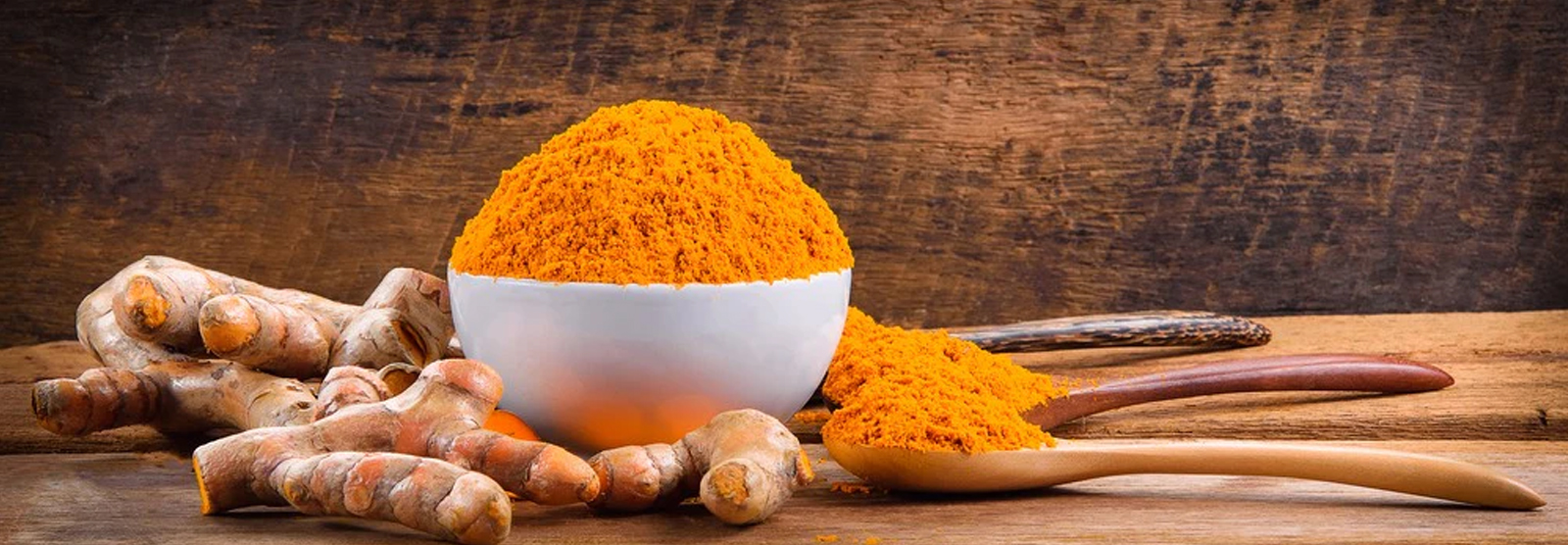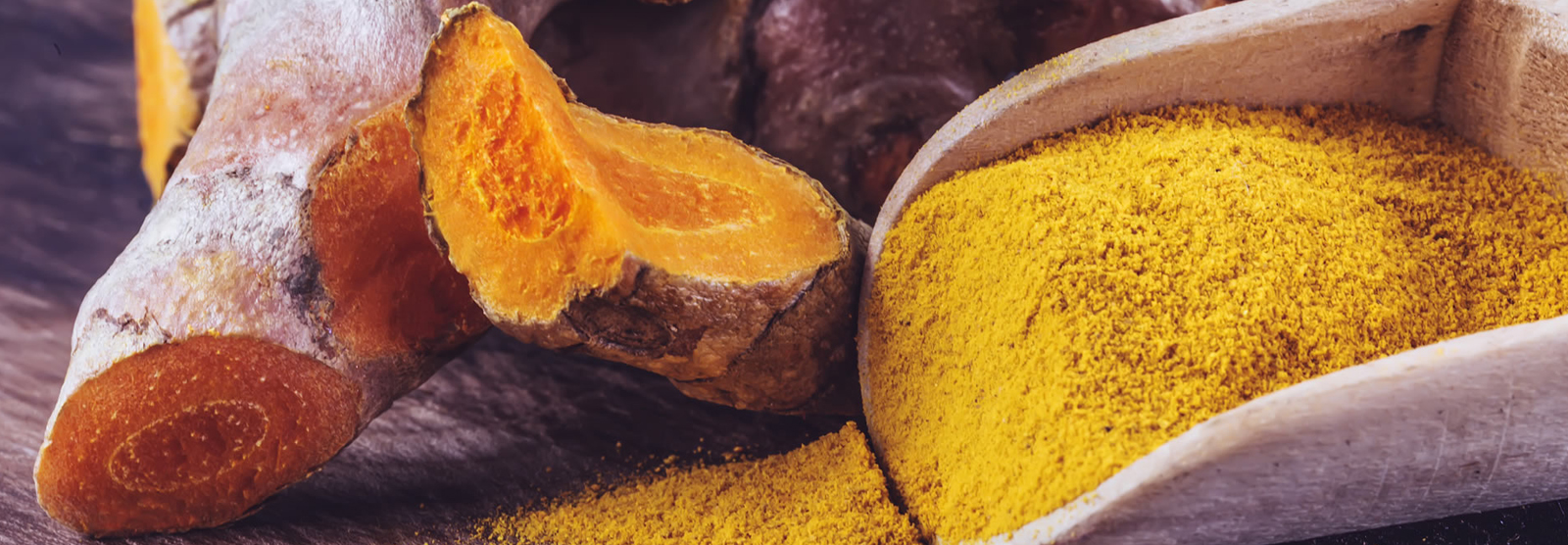Turmeric
Botanical Name
Curcuma longa L.
Family
Zingiberaceae
DESCRIPTION
Turmeric is the boiled, dried, cleaned and polished rhizomes of Curcuma longa. The plant is a herbaceous perennial, 60-90 cm high, with a short stem and tufted leaf. There are 7 to 12 leaves, the leaf sheaths forms the pseudo stem. The lamina is green above and pale green below and has a length of 30-40 cm and width 8-12 cm. Inflorescence is a central spike of 10-15 cm length. 1-4 flowers are born in axil of the bract opening one at a time. About 30 flowers are produced in a spike. Seeds are produced in capsules and there will be one to numerous sunken capsules in an inflorescence.

INDIAN NAME OF SPICES
Hindi : Haldi Bengali : Halud, Pitras Gujarati : Haldhar, Haldi Kannada : Arishia Konkani : Halad Malayalam : Manjal Marathi : Halede, Halad Oriya : Haldil Punjabi : Haldar, Haldhar, Haldi Sanskrit : Haladi, Harita Tamil : Manjal Telugu : Pasupu Urdu : Haladi
FOREIGN NAME OF SPICES
Spanish : Curcuma French : Curcuma German : Kurkuma Gelbwurzel Swedish : Gurkmeja Arabic : Kurkum Dutch : Geelwortel Italian : Curcuma Portuguese : Acafrao-da-India Russian : Zholty Imbir Japanese : Ukon Chinese : Yu.Chin
ORIGIN AND DISTRIBUTIONTurmeric is the boiled, dried, cleaned and polished rhizomes of Curcuma longa. The plant is a herbaceous perennial, 60-90 cm high, with a short stem and tufted leaf. There are 7 to 12 leaves, the leaf sheaths forms the pseudo stem. The lamina is green above and pale green below and has a length of 30-40 cm and width 8-12 cm. Inflorescence is a central spike of 10-15 cm length. 1-4 flowers are born in axil of the bract opening one at a time. About 30 flowers are produced in a spike. Seeds are produced in capsules and there will be one to numerous sunken capsules in an inflorescence. Turmeric is a tropical crop cultivated from sea level to 1200 meter MSL. It grows in light black, black clayey loams and red soils in irrigated and rainfed conditions. The crop cannot stand water logging or alkalinity.
USES
Turmeric is used to flavour and to colour foodstuffs. It is a principal ingredient in curry powder. Turmeric oleoresin is used in brine pickles and to some extent in mayonnaise and relish formulations, non-alcoholic beverages, gelatins, butter and cheese etc. The colour curcumin extracted from turmeric is used as a colourant. Turmeric is also used as a dye in textile industry. It is used in the preparation of medicinal oils, ointments and poultice. It is stomachic, carminative, tonic, blood purifier and an antiseptic. It is used in cosmetics. The aqueous extracts has biopesticidal properties.
FLAVOR CHARACTERISTICS
Bitter, green, medicinal, minty, musty, and woody (4)
TASTING NOTES
The rhizomes contain 2–5% of volatile oil and compounds called "turmerones" are responsible for the characteristic flavor of turmeric. Compared to its cousin, ginger, the flavor of turmeric is not nearly as spicy (2).
Health benefits
1. Turmeric May Soothe Digestion*
Our digestive system is a complex group of organs that helps us breakdown food into the nutrition our
body needs to survive. The lining of the digestive tract can affect how well we absorb nutrients and
also serves as a guard against harmful pathogens. When the lining of the digestive tract becomes
inflamed, this can compromise the barrier. Turmeric spice can soothe the sensitive lining of the
digestive tract, helping it to heal and maintain its intestinal barrier integrity.* This versatile spice also
may stimulate bile production which aids in digestion.*
2. Turmeric Amps Up Fat Burning**
Some studies suggest that Turmeric contributes to a positive reaction in the body’s storage of fat by
influencing Janus Kinase enzymes.* These enzymes have various functions, but they can also increase
pro-inflammatory markers. Initial studies suggest that turmeric’s lessening of the activity of these
enzymes encourages the body’s use of fat for energy instead of storing the fat.**
3. Turmeric May Enhance Immune Function*
There’s a lot of concern about what we can do to help our immune system function at its best. One
overlooked tip is taking a high quality turmeric supplement. Turmeric helps immune system regulation
by supporting our antibody response.* Antibodies help defend against pathogens and other
microorganisms that can have negative impacts on our health. Add a spoon of turmeric to your cup of
tea or chicken noodle soup for an added boost of immune support, or reach for turmeric capsules like
for quick and easy convenience.*
4. Improves Skin Complexion*
Could your complexion use a bit of a pick me up? Many skin concerns have one root causeinflammation.
Taking turmeric internally or using topical products with this herb may calm irritation.*
With turmeric’s inflammation fighting elements, you can help your skin achieve a more radiant glow.*
5. Turmeric Supports Strong Bones*
Bones are a dynamic structure that is constantly being torn down and rebuilt by bone cells called
osteoblasts and osteoclasts. As we age, this process can become less efficient and bone loss can
occur. Turmeric supports bone density health by helping to reduce osteoclasts’ ability to break down
bone.* This can be a useful benefit for maintaining the health of bones well into your golden years.*
6. Turmeric for Joint Mobility and Stiffness*
Turmeric curcuminoids have garnered many accolades for their inflammation-fighting qualities. Specific
clinical studies have demonstrated improvement in knee joint mobility after supplementation with a high
quality turmeric supplement.* One particular trial found that elderly participants who took turmeric for
three months experienced better mobility and joint comfort on a physical exertion test that included an
80 meter fast-paced walk and climbing nine stair steps.
7. Promotes Healthy Blood Pressure Levels (Already Within Normal Range)*
Blood pressure can be affected by many factors. In our bodies, alpha receptors aid in the expansion
and contraction of blood vessels which directly correlates to blood pressure. Research shows turmeric
supports a reduction in the activity of specific alpha receptors that cause the blood vessels to tighten
and constrict which may support healthy blood pressure (within normal limits).**
8. Curcumin May Improve Circulation Health*
Turmeric not only improves healthy blood pressure within normal range, but it supports overall
circulation and cardiovascular health.* Turmeric compounds help blood platelets become less sticky,
facilitating blood flow.* If you take blood thinners, consult a doctor before supplementing with turmeric.
9. Turmeric Fights Brain Aging*
Protecting the brain from aging factors such as oxidative stress can help with memory and other
cognitive faculties that tend to decline as the years pass.* Curcumin fights against the development of
plaque deposits in the brain which can interfere with long term memory.* Curcuminoids found in
turmeric spice also lessen oxidative stress which supports the lifespan of neurons, our brain’s
messenger cells.*
10. Turmeric’s Role in Liver Health
There is evidence to support that turmeric may positively influence enzymes that are associated with fat
accumulation within the liver.* Turmeric also calms inflammation that can negatively affect liver health.*
11. Support A Better Mood with Turmeric*
One of turmeric’s surprising benefits is how it may prompt a sunnier outlook.* Turmeric supports a
balanced mood by elevating brain derived neurotrophic factor (BDNF) and decreasing inflammation.*
Often a low mood is associated with decreased levels of BDNF circulating in the brain.*
12. Turmeric’s Influence on Blood Glucose
One of the most impactful benefits to supplementing with curcumin is how it may improve your body’s
utilization of sugar.* Maintaining blood sugar within a healthy range has ramifications for many areas of
health including cardiovascular health and even losing weight.* Turmeric enhances AMP-activated
protein kinase (AMPK), which is one of the energy balancing substances in our body.* AMPK
determines when we use fat or glucose sugar for energy. By stimulating the activation of AMPK,
turmeric may support healthy blood sugar levels.**
13. Oxidative Stress Support for Eye Health*
The eye is subject to damage from light, pollution and other sources. A strong antioxidant like turmeric
can help with sensitive eye tissues and promote vision health.*
14. Promotes Beneficial Gut Bacteria*
The gut is more integral to wellness than we may realize, with some scientists even referring to it as the
”second brain” due to the amount of neurotransmitters produced in the gut.* One of the ways to keep
the gut functioning at its best is to encourage diverse types of “good” bacteria.* Beneficial bacteria help
ease digestion of food, breaking it down into usable nutrients.* They also shield against harmful
bacteria which supports the immune system.* Curcumin is able to survive transit through the digestive
system into the large intestine where beneficial gut bacteria are found.* Research suggests curcumin
can function as a prebiotic food source which supports the gut’s microbiome.**
15. Turmeric for Respiratory Health
The respiratory system, particularly the lungs, can easily become inflamed from outside pollutants.
Turmeric can assist the calming of inflammation in the airways of the respiratory system with
antioxidant elements.**
16. Promotes Balanced LDL Cholesterol *
Current research on turmeric suggests it may have a benefit for balancing cholesterol lipids.* Turmeric
components may improve LDL cholesterol levels and lessen oxidation of LDL cholesterol.* Preventing
the oxidation of cholesterol is important for heart health since it can cause blood vessels to stiffen and
become fragile.**
17. Turmeric May Improve Sleep Patterns
If you have trouble getting quality sleep, turmeric supports a restful night’s sleep.* Turmeric’s effects
are not as pronounced as melatonin or valerian, but some studies show it can improve time spent in
non-rapid eye movement sleep or NREMS.* This stage of sleep is important for the body’s repair
processes.**
18. Muscle and Workout Recovery
When you workout, it’s completely normal to experience soreness from time to time. Turmeric may give
you a leg up in your workout goals by helping muscles recover from physical exertion more efficiently.*
Some studies show that muscle soreness can be reduced by taking turmeric, likely because of its antiinflammatory
qualities.**
19. Supports Detoxifications
Turmeric has a longstanding history of being used for detoxification and scientific research backs up
this claim.* Research concludes that turmeric components can assist in the body’s detoxification of
heavy metals such as mercury which are common pollutants in the environment.*
20. Turmeric Fights Free Radicals*
The reason why turmeric affects so many key areas of health is because it is a powerful antioxidant.*
Its curcuminoids can quell some of the damage caused by free radicals, unstable molecules that can
wreak havoc on our cells.* Curcuminoids ability to neutralize free radicals is directly tied to its
usefulness in improving wellness.*


